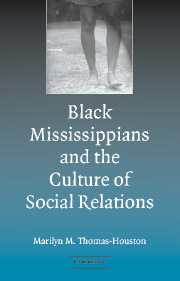Book contents
- Frontmatter
- Contents
- Preface
- Acknowledgments
- Introduction
- PART ONE THE CULTURAL HISTORY AND SOCIAL STRUCTURE OF THE REGION
- 1 Placing the Stones: The Construction of a Region
- 2 Getting Around the Stones: The Civil Rights Movement
- PART TWO SOCIAL CONSCIOUSNESS, SOCIAL ACTION
- PART THREE CONSTRUCTION OF AN INTRARACIAL IDENTITY
- Conclusion
- Appendix A Lafayette County Population Chart
- Appendix B Proclamation Honoring Ole Miss Demonstrators
- Appendix C Chancellor's Statement of Commendation
- Appendix D Speech by Susie Marshall for Second Baptist Church Honoring Rev. Blind Jim Ivy
- Appendix E Susie Marshall's Unpublished Draft of Freedman Town Marker Dedication Speech Recounting July 4, 1867, Speech of Oxford Ex-slave
- Bibliography
- Index
2 - Getting Around the Stones: The Civil Rights Movement
Published online by Cambridge University Press: 23 December 2009
- Frontmatter
- Contents
- Preface
- Acknowledgments
- Introduction
- PART ONE THE CULTURAL HISTORY AND SOCIAL STRUCTURE OF THE REGION
- 1 Placing the Stones: The Construction of a Region
- 2 Getting Around the Stones: The Civil Rights Movement
- PART TWO SOCIAL CONSCIOUSNESS, SOCIAL ACTION
- PART THREE CONSTRUCTION OF AN INTRARACIAL IDENTITY
- Conclusion
- Appendix A Lafayette County Population Chart
- Appendix B Proclamation Honoring Ole Miss Demonstrators
- Appendix C Chancellor's Statement of Commendation
- Appendix D Speech by Susie Marshall for Second Baptist Church Honoring Rev. Blind Jim Ivy
- Appendix E Susie Marshall's Unpublished Draft of Freedman Town Marker Dedication Speech Recounting July 4, 1867, Speech of Oxford Ex-slave
- Bibliography
- Index
Summary
The 1960s was a trying time for the United States' system of democracy and especially so in Mississippi. Cornel West (1996), reiterating conclusions drawn by DuBois, Myrdal, and others, states that the problem of the twentieth century is the problem of the color line, which has contributed to the “arrested development” of democracy and undermined the power of everyday people to determine their destiny. This arrested development manifested itself in numerous ways that affected the quality of life for most Blacks in the United States. The intent of the Civil Rights Movement of the 1960s was to change those deprived conditions. The extremely oppressive conditions in Mississippi made it a targeted area for concentrated efforts to improve the quality of life of its Black citizens. As a result, Mississippi tops the list in numbers of slain civil rights workers. The reign of bombings and burnings occurring throughout its countryside during the 1960s and 1970s gave testimony to the potentially revolutionary activities being born within its borders. The efforts at directed change in Mississippi during the 1960s make the period of the CRM an ideal temporal marker from which to begin an analysis of social change issues in Black communities.
To understand the behavior of Black residents in Lafayette County, Mississippi, during a mobilization effort in the 1990s, it is necessary to situate the history of the movement in Lafayette County within the history of the larger Civil Rights Movement.
- Type
- Chapter
- Information
- 'Stony the Road' to ChangeBlack Mississippians and the Culture of Social Relations, pp. 54 - 66Publisher: Cambridge University PressPrint publication year: 2004



